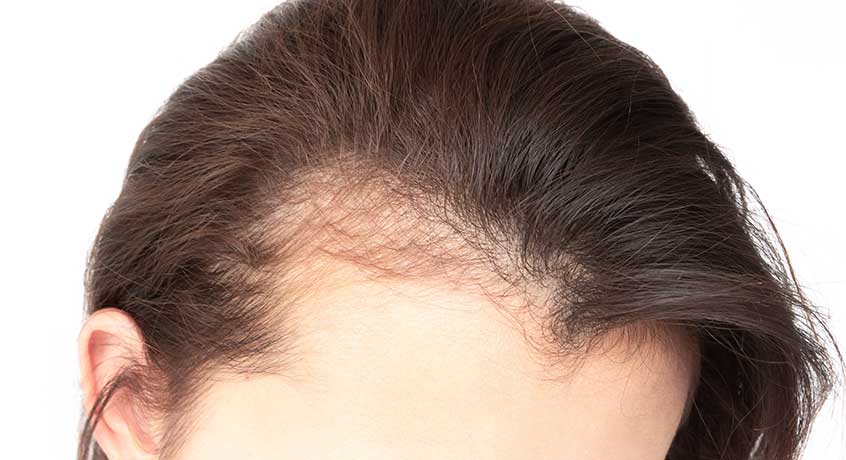
Hair Loss on Women and Men
Male pattern baldness often affects men with a family history of hair loss. When men reach puberty, testosterone levels increase, including a derivative of testosterone called dihydrotestosterone (DHT). Some men are genetically more sensitive to DHT. This results in a shortening of the anagen growth phase of the follicle cycle and a lengthening of the resting phase telogen. The follicles shrink, so that the hair becomes thinner and eventually cannot grow at all. We call this follicular miniaturization.
Miniaturized hair follicles can remain viable for several years, meaning that non-surgical treatments can slow or reverse the effects of hair loss if applied early enough. However, once the follicles have become dormant, it is not possible to regrow hair.
Male pattern baldness manifests itself in a very distinctive way. While the hair on the sides and back of the head usually continues to grow throughout life, hair loss almost always begins at the temples, at the front hairline and then at the crown of the head, where the two eventually combine to form a distinct baldness.
The Norwood Scale is a scale developed by Dr. Norwood to determine how far those with hair loss problems have progressed in this process.
Treatment of Male Pattern Hair Loss
Although male pattern hair loss is a very common condition, it causes psychological problems in almost every man who experiences it. It can affect men's self-confidence and even their relationships and careers.
It is normal to seek a solution for male pattern baldness and there are many treatment options available today. While non-surgical treatments produce non-permanent, temporary solutions, applications such as hair transplantation offer permanent solutions.
Create a preliminary interview request for all your questions about Hair Loss and PRP procedures.
Scientific
Safe
Effective
Female Pattern Hair Loss
Female pattern baldness, also known as hormonal hair loss or androgenic alopecia, is surprisingly common and we know that it affects up to 30% of the female population at some stage in their lives. Whereas male pattern baldness is usually concentrated in the frontal hairline, temples and crown, female pattern baldness has a preserved hairline but progresses as a total thinning, spreading pattern. Hair loss in women can be associated with a number of factors such as genetic predisposition, abnormal hormone levels, underlying medical conditions, stress and even faulty diet. This is why a thorough evaluation is so important to identify and treat the problem. This alone can reverse hair loss, but if not, and if the female patient has sufficient donor hair resources, we can consider hair transplantation.
Unfortunately, many women are not suitable candidates for hair transplantation because there is a risk of continued thinning after surgery, or even acceleration of the hair loss problem caused by the surgery itself due to stress.
Creating a Natural Look
Follicular Unit Extraction (FUE) and Follicular Unit Transplantation (FUT) techniques, which are almost never performed anymore but are considered the ancestors of FUE, are accepted microsurgical applications in hair transplantation. Of course, these 2 hair transplant techniques require a high level of technical skill and experience. But this is only part of the story.
The goal of a good hair transplant design is to create a result that looks completely natural and provides the desired amount of coverage for as long as possible. To achieve this, there is much more to it than the technical procedure of transferring follicles. Hair transplantation also requires artistic perspective and skill. Personalized planning and the correct guidance of the hair transplant team are also very important.
Hair does not grow in regular and symmetrical patterns. Rather, they normally grow in follicular units, which are groups of one to four hair follicles per unit. When performing hair transplantation, the follicular units should be placed in a soft, irregular shape on the hairline and designed in accordance with the patient's facial features and head shape because everyone is unique, one of a kind and this is the only way to create a natural look.
When the transplanted hair grows, it must blend seamlessly with any hair strand to achieve a completely natural look. In short, there should be no difference in appearance between the transplanted hair and the existing hair.
In order to achieve this final result, the hair transplant specialist must take into account many factors, including the way the existing hair grows, the general appearance and the age of the patient, and plan accordingly. The hair transplant specialist cannot just follow a formula or template, he/she must create a personalized hair design and then carefully work on the position, angles and directions of the transplanted hair during transplantation.
